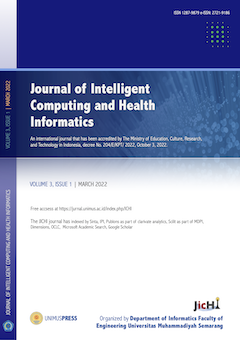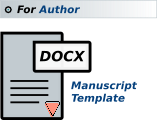Naïve Bayes Algorithm for Classification of Student Major’s Specialization
(1) UIN Sultan Syarif Kasim Riau
(2) UIN Sultan Syarif Kasim Riau
(3) UIN Sultan Syarif Kasim Riau
(*) Corresponding Author
Abstract
Keywords
Full Text:
PDFReferences
Baker, R. C. (1989). Nonlinear unstable systems. International Journal of Control, 23(4), 123–145. Bisri, M. H. (2015). Implementasi Algoritma Naïve Bayes untuk Memprediksi Penjurusan Siswa di SMA Kesatrian 1 Semarang. Jurnal Informatika, 1–7.
Bustami. (2014). Penerapan Algoritma Naive Bayes Untuk Mengklasifikasi Data Nasabah Asuransi. TECHSI - Jurnal Teknik Informatika, 8(1), 127–146. https://doi.org/10.26555/jifo.v8i1.a2086
Hasan, M. (2017). Menggunakan Algoritma Naive Bayes Berbasis. ILKOM Jurnal Ilmiah, 9(3), 317–324.
Hastuti, K. (2012). Analisis Komparasi Algoritma Klasifikasi Data Mining untuk Prediksi Mahasiswa Non-Aktif. Seminar Nasional Teknologi Informasi & Komunikasi Terapan 2012 (Semantik 2012), 2(1), 241–249.
Hayuningtyas, R. Y. (2017). Aplikasi Filtering of Spam Email Menggunakan Naïve Bayes. IJCIT (Indonesian Journal on Computer and Information Technology), 2(1), 53–60.
Kadafi, A. R. (2018). Perbandingan Algoritma Klasifikasi Untuk Penjurusan Siswa SMA. Jurnal ELTIKOM, 2(2), 67–77. https://doi.org/10.31961/eltikom.v2i2.86
Khasanah, F. N. (2016). Klasifikasi Proses Penjurusan Siswa Tingkat SMA Menggunakan Data Mining. Informatics for Educators and Professionals, 1(1), 65–69.
Liliana Swastina. (2013). Penerapan Algoritma C4.5 untuk Penentuan Jurusan Mahasiswa. Jurnal Gema Aktualita, 2(1), 93–98.
Naparin, H. (2016). Klasifikasi Peminatan Siswa SMA Menggunakan Metode Naive Bayes. Systemic: Information System and Informatics Journal, 2(1), 25–32. https://doi.org/10.29080/systemic.v2i1.104
Nugroho, Y. S. (2015). Klasifikasi dan Klastering Penjurusan Siswa SMA Negeri 3 Boyolali. Khazanah Informatika: Jurnal Ilmu Komputer Dan Informatika, 1(1), 1. https://doi.org/10.23917/khif.v1i1.1175 Rosandy,
T. (2016). Perbandingan Metode Naive Bayes Classifier dengan Metode Decision Tree (C4.5) untuk Menganalisa Kelancaran Pembiayaan (Study Kasus : KSPPS / BMT AL-FADHILA). Jurnal Teknologi Informasi Magister Darmajaya, 2(01), 52–62.
Saleh, A. (2015). Klasifikasi Metode Naive Bayes Dalam Data Mining Untuk Menentukan Konsentrasi Siswa. KeTIK, 200–208.
Saleh, Alfa, & Nasari, F. (2018). Penggunaan Teknik Unsupervised Discretization pada Metode Naive Bayes dalam Menentukan Jurusan Siswa Madrasah Aliyah. Jurnal Teknologi Informasi Dan Ilmu Komputer, 5(3), 353. https://doi.org/10.25126/jtiik.201853705
Sofanudin, A. (2017). Program studi sistem informasi fakultas teknik universitas nusantara pgri kediri tahun 2017. Simki-Techsain, 01(03), 1–6.
Yusra, Olivita, D., & Vitriani, Y. (2016). Perbandingan Klasifikasi Tugas Akhir Mahasiswa Jurusan Teknik Informatika Menggunakan Metode Naïve Bayes Classifier dan K-Nearest Neighbor. Sains, Teknologi Dan Industri, 14(1), 79–85. https://doi.org/10.1002/mame.201200226
Article Metrics
Abstract view : 2705 timesPDF - 469 times
DOI: https://doi.org/10.26714/jichi.v1i1.5570
Refbacks
- There are currently no refbacks.
____________________________________________________________________________
Journal of Intelligent Computing and Health Informatics (JICHI)
ISSN 2715-6923 (print) | 2721-9186 (online)
Organized by
Department of Informatics
Faculty of Engineering
Universitas Muhammadiyah Semarang
W : https://jurnal.unimus.ac.id/index.php/ICHI
E : jichi.informatika@unimus.ac.id, ahmadilham@unimus.ac.id
This work is licensed under a Creative Commons Attribution-ShareAlike 4.0 International License.









